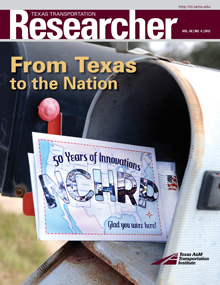
Moving freight along waterways is nothing new in the United States. In fact, historically speaking, waterways were more important to U.S. commerce than any other mode until the advent of railroads. With highways more congested than ever and safety and environmental concerns associated with moving hazardous materials via rail, some are seeing America’s waterways as an attractive, alternative mode.
To evaluate their potential as a substitute for road and rail, the U.S. Maritime Administration has launched the North American Marine Highways (NAMH) Initiative. Despite situations that would seem to favor short-sea shipping and the development of marine highways, the freight community has not embraced the idea of moving a larger share of its cargo over water. Jim Kruse, director of the Texas A&M Transportation Institute’s Center for Ports and Waterways, recently co-authored a white paper examining the whys and wherefores of moving freight via marine highways.
“In this report, we examined both successful and unsuccessful shipping ventures, shipper requirements, vessel considerations, legislation and obstacles impacting NAMH,” says Kruse.
The white paper, NCFRP 17: North American Marine Highways (Report 5), results from an extensive literature review and interviews with a diverse group of stakeholders, and examines the many facets that go into the planning and operation of current and future marine highway services. Kruse concludes that numerous obstacles stand in the way of marine transport start-up businesses, including:
- lack of statistical data regarding trade flows,
- lack of equipment that qualifies under current statutes and regulations,
- shippers unfamiliar with the process or the benefits, and
- flow-imbalance issues (significant volume of cargo differences moving in both directions).
Kruse’s findings make it clear that in most instances marine highway shippers and operators are not currently cost competitive with existing alternatives. “There will be no major development of a marine highway system until the overall framework changes,” Kruse states.
In his foreword to the report, Transportation Research Board Staff Officer William Rogers says it will help stakeholders better understand how use of today’s marine highway system could be improved. “The report is especially valuable for its assessment of the conditions of feasibility; its analysis of the economic, technical, regulatory, and logistical barriers inhibiting greater use of the marine highway system; and proposed solutions for barrier elimination,” writes Rogers.
In a second phase of the project, Kruse explored the possibility of transporting heavy and hazardous shipments over water — specifically chlorine and anhydrous ammonia, classified as toxic inhalation hazard (TIH) materials. NCFRP 17: Marine Highway Transport of Toxic Inhalation Materials (Report 18) examined chlorine and ammonia because of their widespread use — ammonia, in the agricultural industry, and chlorine, in 45 percent of all commercial products. The study sought to develop a business case for transporting a larger share of these materials via waterways. The findings weren’t encouraging.
“Unless there are major market or regulatory shifts, we do not anticipate a diversion of TIH materials from rail to marine highway transport,” Kruse concludes. He says the biggest obstacles to marine transport are that the TIH market is not growing and users of the materials are so geographically dispersed, making it difficult to achieve economical load quantities.

